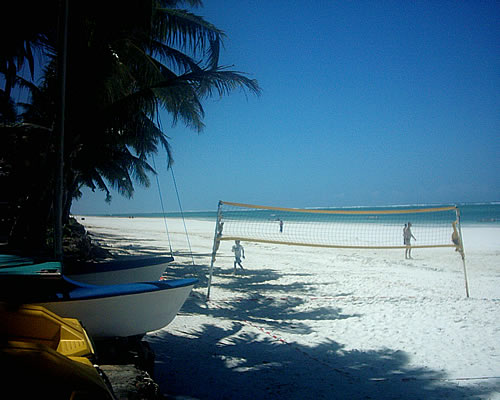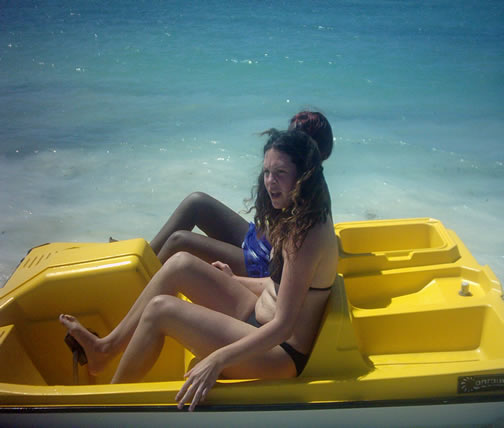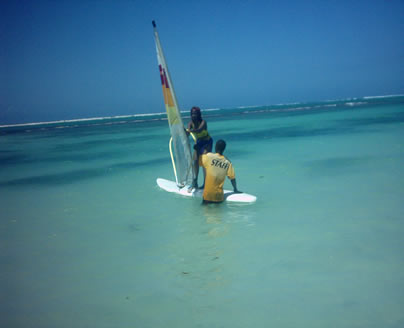|
Country Info
....................................................................................................................................
The Kenyan Coastline
South Coast

Activities
Water sports
This is the third morning of our stay at the Alliance Safari
Beach hotel (currently closed), and we're out to try the sporting
activities on offer, both the challenging and the not-so-challenging
that are possible for everyone to engage in.
The ocean's waters are a bit rough as it is mid-year, the
so-called ‘monsoon season' here. So if you would rather come to the
coast at a time when the sun is out more and the ocean calmer, plan
your holiday between September and March.
The Alliance group of hotels has three hotels neighbouring each
other, but the water sports are a predominant feature of the Jadini
beach hotel, set on an unbroken stretch of the white sands of Diani
beach. As we wait for the tide to subside we enjoy a beverage on the
spacious terrace. Close by some swimmers are taking an intro course
to scuba diving in the pool.
My sporting companion is Cecilia, a teacher who's also here for
some fun by the sea. First up is the catamaran. Wearing a life
jacket is compulsory, even though the sports are done well within
the reef. The water is cool as we move out. The instructor positions
us on either side of the catamaran for balance, jumps on and we're
off, bobbing up and down. Instructors always accompany guests so as
to allay any fears and basically ensure that you get your money's
worth. He constantly changes the sail's position in accordance with
the direction of the wind. This is actually more relaxing than
taking a ride in an engine-powered motor boat, because the only
sounds here are the wind and the waves. You can hire the catamaran
for a full hour, but since we have more to explore we head back to
shore for the next sport.
Next up is kayaking. Stephanie, who is an expert, briefs me on
the mechanics of kayaking first. It's similar to rowing a boat. I am
rather scared at the prospect of being alone in this craft, though
the instructor rows beside me as I totter on the waves, constantly
giving instructions until I am confident enough. It takes some
getting used to but once you get the hang of it, it feels great
cutting through the waves. After the first round I am deemed
experienced enough to go out on my own.
Next is the pedal boat. Cecilia joins me again on this gadget
that is really simple to handle. All you do is pedal as if you are
riding a bike, and use a gear stick to change direction. And
parents, you can share the fun with your children because there is
space behind the seats where they can be accommodated.
 Pedal boat Pedal boat
Okay, so what's next? Well, it's an activity that I have long
wanted to try out. Windsurfing. First I have to wear rubber shoes
that will offer grip on the surfboard. The instructor then begins
the lesson. Place both hands on the board, drag yourself up, and
then try to rotate while still balancing. This is not easy. The sail
is then connected to the surf board and the instructor then
demonstrates how to climb on and bring it up from the water. Now
it's my turn. The sail is much heavier than it looks, and trying to
balance at the same time doesn't help. But if you fall hey just jump
right back on and try again!
Thankfully the guides are patient. My third attempt is a bit
better, but not quite there yet. Fourth time round and I actually
manage to sail off for some distance. And on the fifth and final
attempt- slowly but surely, off I go!
 Surfing...well, trying to
Surfing...well, trying to
That's that for the water sports (at least for the day!), but it
certainly is great fun for the whole family.
Glass bottomed boat
After lunch we decide to engage in a less strenuous activity. We
will be taking a ride on the Polepole glass bottomed boat up to the
reef.
It is early afternoon and the tide is going out as we set off
from shore. The mid-section of the boat's floor is fitted with a
glass through which we can view the fish swimming over the coral
reef in the now shallow water.
So as to attract the fish, one of our guides picks a sea urchin
from the coral for the fish to feast on. This is a delicacy for them
because normally they cannot penetrate the thorny skin to get to the
soft insides.
Glass-bottom boat rides work well for people who do not want to
get their feet or body wet snorkelling. You will still get to see
some fish and coral reef formations. As we head back to shore we
pass some fishermen in a jahazi on their way out to fish.
An alternative to all these activities, is, of course, basking on
the beach, maybe even get your hair braided and a temporary tatoo
imprinted in hina by the friendly ladies selling colourful
khangas and curios along the beach.
Kaya Kinondo
Herman Melville once stated that “It is not down in any map;
true places never are.”
Well I certainly discovered this first hand when we visited a
magnificent forest that is a living museum of a people's traditional
culture. It is the morning of my final day on the Kenyan south
coast. We drive south along the Diani road upto a point that ends up
as murram road.
8 kilometres from our hotel the Kaya Kinondo sacred forest looms
ahead. To welcome us, Digo dancers have prepared a song. As is the
norm, we are first dressed up in black cloth that is worn
traditionally by the tribe. After this the medicine woman gives me a
name. My new name is ‘Mghaye', which in Kiswahili means
‘maskini wa Mungu' but can be generally translated to mean
‘one who humbles herself before God'.
I am honoured because the medicine woman carries the same name.
Once the introductory dance is over we receive a demonstration
into how the medicine woman casts out spirits. She can also
prophesy. To aid the possessed woman, she splashes water on her and
discovers that what is possessing her is a charm that has been
buried. So my new namesake sets off to locate it by sniffing special
medicine. Once unearthed, the possessed woman is free from the
demons.
After this, we are briefed about the tour of the scared forest by
Mr. Mwafujo our guide. Certain rules abound here- there should be no
wearing of scarfs or hats, no smoking or kissing, and stick to the
trails. Photography is only allowed in selected areas. This is a
sacred forest so we should treat it as though we were in a church.
The walk takes from 45 minutes to one hour.
After we are shown a map that indicates our planned walk, we stop
at a shrine situated at the entrance to the kaya, which is
a Mijikenda word for ‘village'. The villagers would pray
here so as to gain entry to the forest, however only a specific
prayer was known per village, so if one said the wrong words then
entry was denied. As we walk into the forest we encounter a cool
diverse ecosystem that is in contrast with our warmer surroundings.
Coral rocks line the forest's floor, indicating that it was once
underwater.
The first tree that we stop at is a strangler fig that is choking
the life out of a main tree that is now barely visible. Strangler
roots at first hang upside down before taking root in the ground.
The next tree is known as Mdege in the Mijikenda
language. Its bark was used to make clothing for women. The bark was
first peeled off, then beaten with a stick to soften it, buried for
three or four days after which it would stretch into a soft
blanket-like material.
A vast canopy looms overhead as we continue on our trek. Watch
your step because of the jutting coral rocks. Preferably wear closed
shoes.
It is strange to visit a forest like this so close to the beach,
when all you would expect to see are coconut trees. Well, as Mwafujo
says, this is precisely why we have to preserve it.
The next plant of interest is a cycad, and its species is said to
be from the Jurassic age of dinosaurs. One particular one is 600
years old.
Then there is the tree that was used to make men's clothes. It is
called Mnguonguo. And an added bonus is the notion that if
you hug a tree for half an hour everyday for one month it will lower
your blood pressure. This has apparently been scientifically proved!
So we all take a turn hugging it.
Other plants of significance exist in this forest, including one
that treats sinuses.
|
Kaya Kinondo Ecotourism project
is a community owned and managed initiative aimed at enhancing
conservation and distributing tangible social economic
benefits to the community. The Mijikenda have a four-day
calendar. This kaya is open on the first three days only, so
please enquire before making your way here.
|
We finally get to an open area that was the location of the main
village. We are shown a liana that has multiple uses; first it is
used to indicate the presence of a high water table, secondly when
cut it produces fresh water, something that remains a mystery
because it grows in a salt water area. And lastly, it is the
traditional version of Viagra.
Further on we face the only place where you may not take
pictures. The most sacred spot in the whole forest, where the
tribe's sacred magical object is buried. Nearby is a giant palm that
was planted by the founder of this Kaya, estimated to be over 600
years old!
It was also the scene for a traditional dance called
‘janja' that the villagers would perform when praying during
calamities like famine and war. Mwafujo emphasises the fact that
this is an area that must be respected. Cases have occurred where
strange things happen to guests who go against any of the rules
governing this sacred grove.
Kaya Kinondo is a place that will fascinate anyone
who is interested in history and culture, as it bears the marks of
prolonged human use and settlement.
|
The south coast...
- Diani is home to a range of world class
resorts
- Its beaches are bordered by lush coastal
rainforests that are home to rare colobus monkeys
- It offers a range of activities, day-trips
and excursions for visitors interested in the environment of
the coast, the unique species of trees, plants, birds and
mammals
- Diani's offshore reefs offer world class
diving with spectacular coral gardens
|
Poolside dinner
Tonight we dine in style by the well-lit swimming pool. A fine
buffet has been laid out under the stars. All the guests are
relaxed, as food somehow always tastes better outdoors. It's a warm
evening and I am joined by my newly-made Jamaican friends. It has
been said that Food is the most primitive form of comfort, and what
better way to enjoy it than in the company of good people,
exchanging stories about our different cultures and countries. This
is definitely one great thing about travelling- making new friends
from diverse places.
After dinner we are entertained by one of the best acrobatic
troupes I have ever watched. And with this live
performance ends an active, exciting day at the coast.
Accommodation rates
and images
Related link: North
Coast
Copyright 2007. All rights
reserved. Exotic Expeditions
Limited. | 


